Western Wildfires Damage, Contaminate Drinking Water Systems
As they tear through forests and developed areas, fires in California, Oregon, and Washington have destroyed water infrastructure and released chemical contaminants.
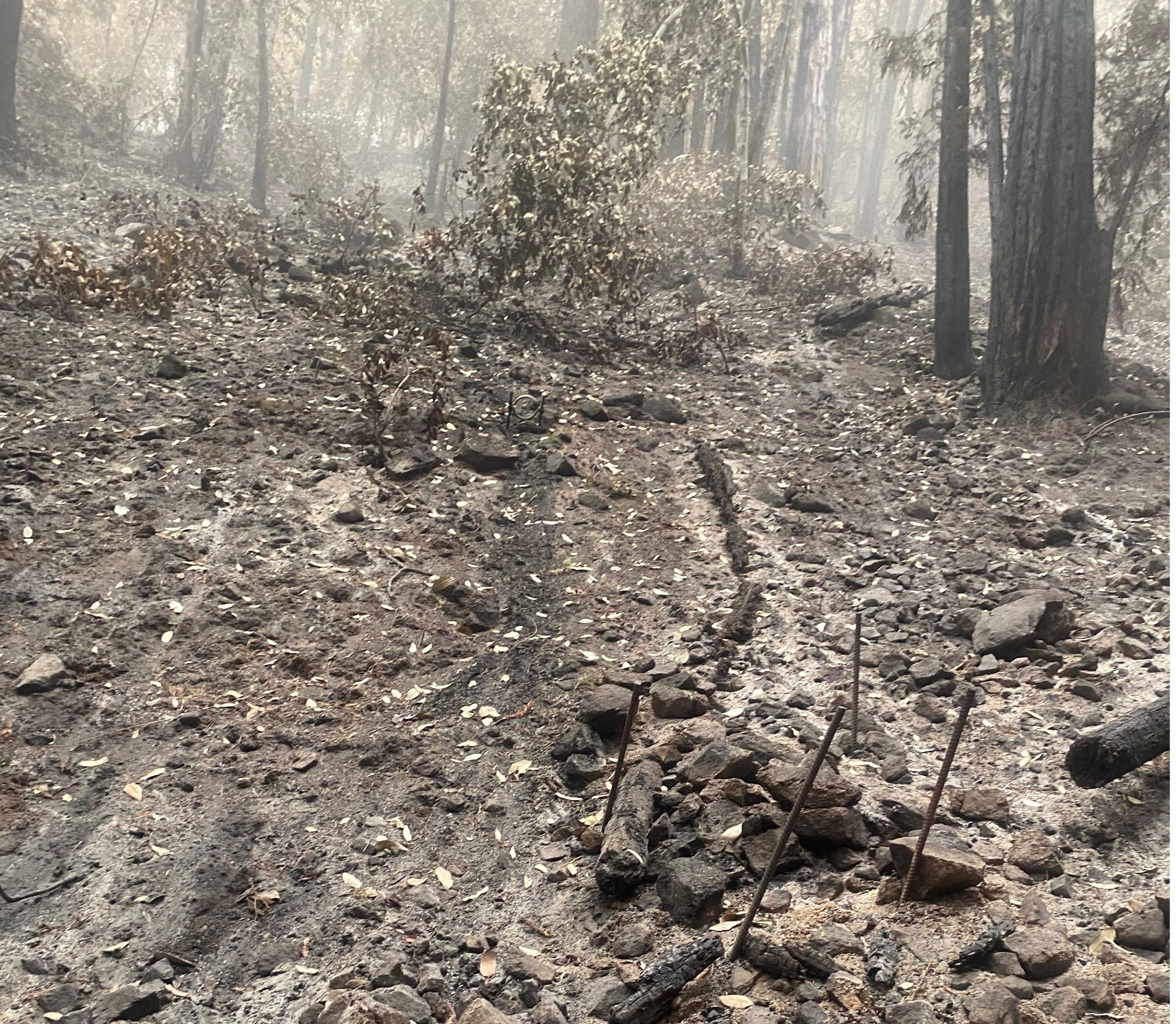
The CZU Lightning Complex Fire burned through the forests of Santa Cruz County, California. The fire damaged water infrastructure for San Lorenzo Valley Water District. Photo courtesy of Carly Blanchard/SLVWD
By Brett Walton, Circle of Blue
The American West is in flames, ablaze in one of the region’s worst fire episodes in the last hundred years.
More than 300,000 acres burned in Washington state on Monday, twice the total acres that burned in all of 2019.
In Oregon, the small towns of Detroit and Gates were leveled by wind-fueled flames racing down Santiam Canyon. As of Thursday night, a half million people in the state lived in areas under evacuation orders or alerts.
In California, where a record 3.1 million acres have burned this year, thick banks of smoke enveloped the Bay Area, obscuring mid-day skies with an eerie orange hue. The U.S. Forest Service, citing extreme fire risk, earlier this week closed all national forests in the central and southern parts of the state to visitors.
Taking refuge in hotels, emergency centers, or with family, many people do not yet know whether their homes are still standing. Where evacuation orders have been lifted, the damage is readily apparent. Not only have houses and businesses been scorched. Essential public infrastructure has been destroyed. That includes drinking water systems, which in some cases are showing signs of contamination from chemicals released during the fires.
State and local agencies say they are still surveying water system damage and do not have precise information at this time. The Oregon Health Authority said that it has heard of a number of small water systems along the Interstate 5 corridor between Ashland and Medford that have been destroyed. The Washington State Department of Health says that 11 water systems lost pressure during power outages connected to fires in that state. Their customers are being advised to boil their water or use bottled water for drinking.
One of the most severe examples is the San Lorenzo Valley Water District, which serves parts of inland Santa Cruz County, in central California. More than 7 miles of an HDPE plastic water supply pipeline were destroyed in the CZU Lightning Complex Fire, according to Rick Rogers, the district manager. The pipe was primarily located above ground. Most of the district’s water system was spared in the fire that started on August 16, and the district has switched to backup water sources, including groundwater. But Rogers listed other infrastructure impairments: damage to booster pumps, transmission mains, tanks, intakes, water meters, and sampling stations in certain areas. The preliminary, back-of-the-envelope damage estimate is $10 million.
Parts of the district have been under a Do Not Drink/Do Not Boil advisory since August 29 due to benzene contamination. Very few water samples have been tested so far — several dozen from 25 points in the distribution system — but one taken on September 4 revealed benzene contamination above the state drinking water standard, which is 1 microgram per liter. The sample measured 2.7 micrograms per liter.
Earlier this week, the district lifted the Do Not Drink/Do Not Boil order for parts of the service area that did not show benzene contamination, but staff said they did not know when the all-clear sign would be flashed district-wide.
“This is a marathon, not a sprint,” Nate Gillespie, San Lorenzo Valley water treatment and system supervisor, said during an online meeting on September 3.
A New Era
The destruction and contamination of drinking water systems is a new and unsettling chapter in the story of wildfires in the West. Past fires have burned watersheds, depositing into reservoirs debris and ash that interfere with the water-treatment process. Now, subdivisions are burning, putting the plumbing itself at risk.
Nine of the 12 most destructive wildfires in California history, measured by the number of structures that burned, have occurred since 2015. As housing developments expand into areas vulnerable to fire and a warming planet increases the likelihood of large conflagrations, water managers and regulators expect to be dealing with the risks to drinking water systems for years to come.
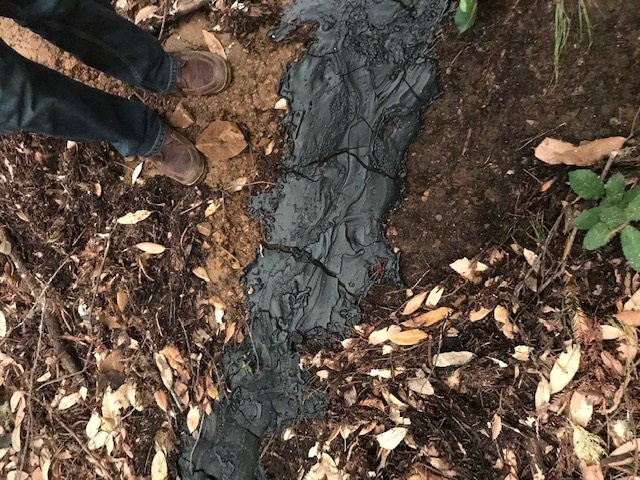
A San Lorenzo Valley Water District staff member stands next to the remains of a plastic water supply pipe that melted during the CZU Lightning Complex Fire. Photo courtesy of SLVWD
“Since about 2015 we started seeing fires that quickly wipe out large sections of community, and it seems like every year since then we’ve seen one fire or the other that has done this, so I fear that it is something we’re going to be living with,” Stefan Cajina of the State Water Resources Control Board’s Division of Drinking Water told Circle of Blue.
In addition to San Lorenzo Valley, a Do Not Drink advisory was also issued by Big Basin Water Company because of damage from the CZU Lightning Complex Fire.
The first instance of fire-related benzene contamination of a public water system in California happened in Santa Rosa, in 2017. The next year the town of Paradise was nearly obliterated by the Camp Fire, which, in addition to killing 85 people, destroyed 90 percent of the town’s structures and inflicted substantial damage to the drinking water system.
Kevin Phillips, formerly the manager of Paradise Irrigation District and now the town manager, told Circle of Blue that the capital cost of rebuilding the water system and replacing contaminated pipes has reached $150 million.
Andrew Whelton, an associate professor of civil and environmental engineering at Purdue University, helped Paradise officials assess the condition of their system after the Camp Fire. He is worried about the thoroughness of post-fire drinking water assessments in other areas.
“The question is, will the safety of those systems be determined appropriately or will substandard approaches be applied and systems put back in use and people won’t know if they are receiving safe water or unsafe water?” Whelton told Circle of Blue.
Drinking water systems can be contaminated by fire in several ways. When pipes break, water pressure drops, which can draw in pollutants from the soil, groundwater, and air, including organic chemicals in smoke. Plastic components of a water system — pipes, meters, valves — can also burn and release chemicals into the water system. These volatile and semi-volatile organic chemicals can vaporize out of water. Short-term exposure can cause dizziness, while long-term exposure can cause anemia or leukemia.
San Lorenzo Valley officials issued their Do Not Drink/Do Not Boil advisory in consultation with the state Division of Drinking Water. Cajina is the chief of the division’s north coastal section, which includes San Lorenzo Valley.
“We recommended that they not use terminology like ‘Do not use,’” Cajina said. “If they say, ‘Do not use,’ then it becomes unclear if people can even do things like use water for basic sanitation or firefighting. And that was certainly not the message we wanted to give. Also we had no evidence that there was going to be anything beyond the normal type of contamination you expect when a system depressurizes.”
The Do Not Drink/Do Not Boil advisory was issued before any water samples had been tested. Cajina said the determination was made based on an analysis of water flows in the system, which areas had lost pressure, and where the fires had burned. He said that district officials acted proactively by closing valves and physically isolating parts of the system before the flames arrived, actions that prevented potentially contaminated water from spreading through the pipes.
After finding benzene, Cajina said that the district, based on the state’s recommendations, revised the language on its public notice. The changes noted that residents in the affected area should limit use of hot water, limit shower time, not take baths, and not use hot tubs or swimming pools — all activities that could vaporize the chemicals.
The district is sampling water only from the distribution system and other points that it operates. Individual homes, which are not being tested, could still be at risk of contamination from their service lines, depending on their proximity to the fire, said James Furtado, director of operations, during the September 3 meeting.
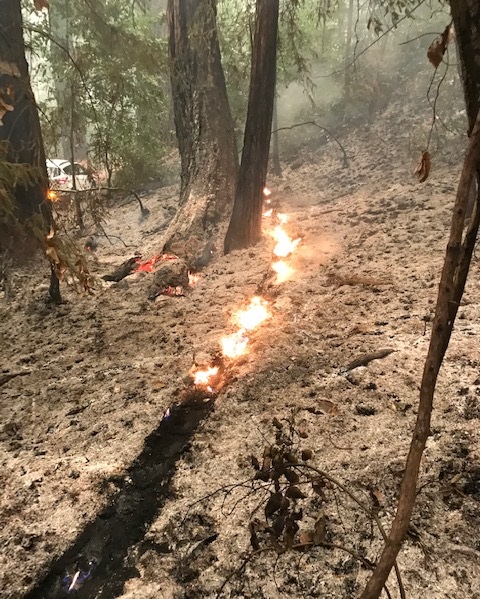
A HDPE plastic water supply pipeline for San Lorenzo Valley Water District burns. Photo courtesy of SLVWD
Towns whose pipes are contaminated have two choices, Whelton said. They can flush out the contaminants or replace the pipes. The best course of action depends on the extent of contamination and the pipe material, he said. Plastic pipes hold organic chemicals like benzene more tightly than steel. Whelton said that, in an analysis from the Camp Fire, a plastic pipe that had severe benzene contamination took more than nine months to reach the point where the pipe supplied water that met the California drinking water standard.
Phillips and Cajina also recommended quickly and repeatedly flushing water in one direction through the system to clear contaminants.
San Lorenzo Valley is aiming to repair its system as quickly as possible in order to get water flowing to all homes in the district. For speed, some plastic components are being reinstalled. A conversation about whether those materials are most suitable for the long-term is a conversation that will happen after the emergency period, Rogers said.
“We are looking at putting these facilities back and hardening them against fire,” Rogers said. “The district does not want to put them back and go through this again.”
Whelton agreed that this new era of fire risk should give authorities reason to reevaluate their infrastructure choices.
“Should plastic pipe have been installed above ground in a forest that is prone to wildfires? No,” Whelton said, referring to the San Lorenzo Valley water supply line that burned. “Unless you expect to have to replace that under a situation where it is damaged. These discussions need to be happening in state capitols and communities that make infrastructure selection decisions.”
This story has been updated to reflect more accurate information from Oregon officials about the number of people in evacuation zones.
Brett writes about agriculture, energy, infrastructure, and the politics and economics of water in the United States. He also writes the Federal Water Tap, Circle of Blue’s weekly digest of U.S. government water news. He is the winner of two Society of Environmental Journalists reporting awards, one of the top honors in American environmental journalism: first place for explanatory reporting for a series on septic system pollution in the United States(2016) and third place for beat reporting in a small market (2014). He received the Sierra Club’s Distinguished Service Award in 2018. Brett lives in Seattle, where he hikes the mountains and bakes pies. Contact Brett Walton

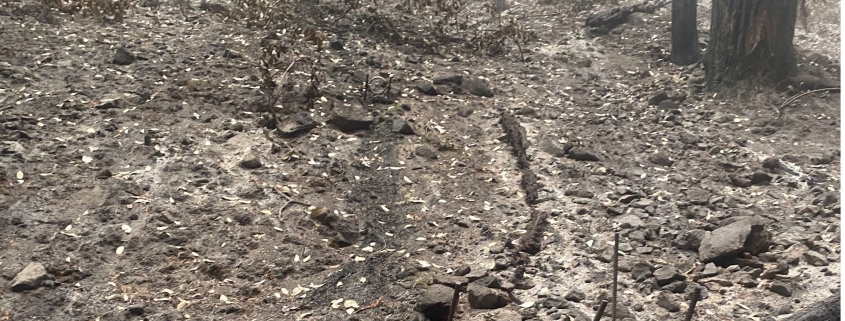

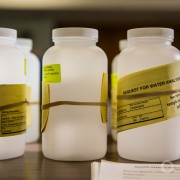
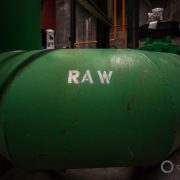
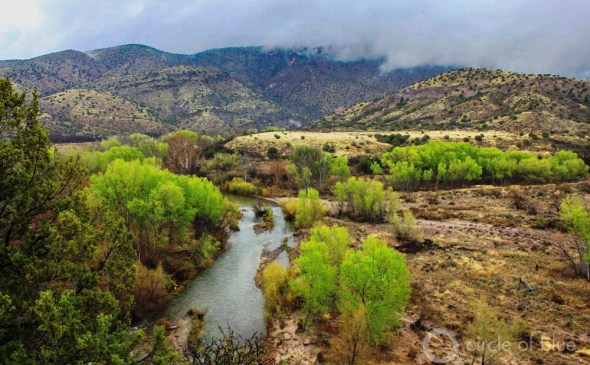
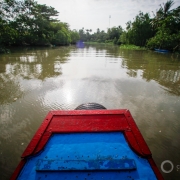
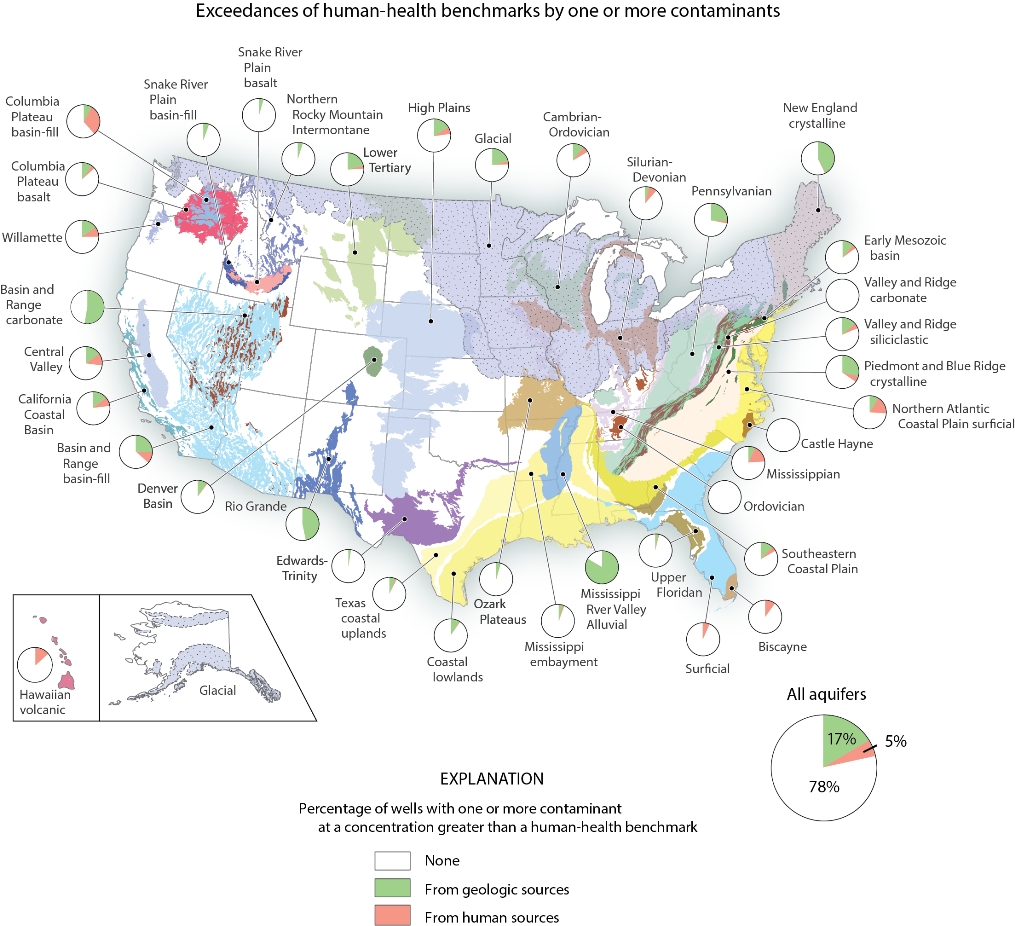
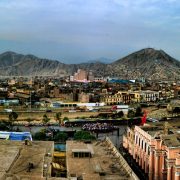



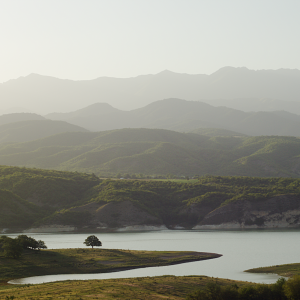
Leave a Reply
Want to join the discussion?Feel free to contribute!